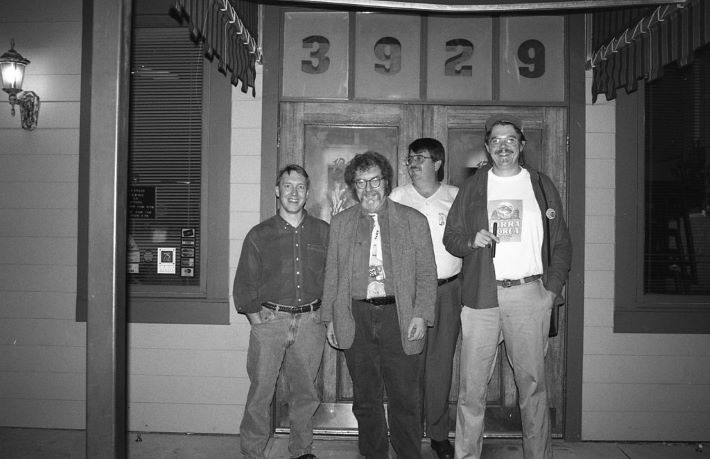
David Pierce, Michael Jackson, Buck Rissler and Roger Baylor. The photo was taken in 1994 when Jackson was touring the United States researching a book that was never written. You can find the story here.
Roger Baylor proudly remembers that Michael Jackson called him a polemicist.
The first time Daria and I wrote about Rich O’s in New Albany, Indiana, in January of 1995 the place had three draft beers, was a “Lite-Free Zone” and encouraged cigar smoking. One tap poured Guinness, one Pilsner Urquell and the “middle tap” rotated. Baylor let customers know in advance what was coming and how many kegs were to be available. By the end of the year, when we compiled our “Beer Travelers Guide,” Rich O’s was up to five taps. Sierra Nevada joined Guinness and Pilsner Urquell as a regular and there were two rotating taps.
By 1999, when we assembled “The Beer Lover’s Guide to the USA” Rich O’s had well-chosen 20 taps.
Twenty-one years ago, when I wrote about what was going on inside of some bars in the days after the terrorist attacks commemorated yesterday, he was the first one I called for a column that began:
In the hours immediately after terrorists flew airplanes into the Pentagon and New York City’s Twin Towers on Sept. 11, Rich O’s Public House publican Roger Baylor paced anxiously between his pub and Pizza Time, the restaurant/bar next door that he also owns. Pizza Time has television sets; his pub does not.
“I was freaking out, basically,” he said. He began to think of the many people with whom he wanted to talk, who he should call. “Then I realized that I didn’t have to. I thought, ‘They’ll all be in here.’” Sure enough, as shifts ended regulars began to drift in. “There are a group of us, well I’m always here, we all sort of appear at the same time,” Baylor said.
The regulars discovered that Baylor had put a television on the counter up front – the first time a TV had been in the bar in three years. Those who wanted the latest news could get it, then find seats out of television range. “People would retreat back into the bar to talk, to get away from these images for a while,” Baylor said. “The first few days there was only one thing (the terrorist attacks) that they talked about.”
I offer this to provide context to a post last week in which Baylor contemplates retirement. He is younger than I am, and that is something I certainly haven’t figured out. Reading it I was reminded that what we expect beer might taste like has changed in 1995, but how we expect it might enhance the quality of our day to day hasn’t. Also, that while it may be cool to be a publican, it is also kind of shitty.
We can do better, right?
The story brilliantly delivers what the headline, “Women’s Work — What the Story of a 17th-Century Brewster Can Teach Us About 21st-Century Brewery Ownership,” promises.
It asks questions.
“What barriers, for example, did women like (Sarah)Frankes face when entering the 17th-century beer trade? How common were such brewsters’ experiences, and how did their work integrate into their larger, complex worlds? And most importantly, is this past really in the past, or is it something 21st-century women in beer have inherited?
“Equally, we can ask difficult questions about gender and brewery ownership today. Why are so many women brewery owners today married to their co-owner? What happens when a single woman who wants to open a brewery seeks funding? And if we ask you, right now, to picture an archetypical brewmaster, how many of you imagine a cis man?”
And more questions.
“But in excavating what we can of these histories, contemporary champions of women in beer must ask what conditions would enable even greater participation for women—especially those with fewer financial resources—to continue in the spirit of (Mary Lisle) and Frankes. The industry is eager for women to participate, but larger socioeconomic forces have always to some degree constrained the choices women are able to make about business ownership.”
Related: “Women Entrepreneurs Who Have Launched Their Own Beer Industry Businesses.”
You might also enjoy
– After this story about TRU Colors Brewing this news doesn’t seem like much of a surprise.
– The best beer cities in the United States? Happy to see Milwaukee so high, but wondering why St. Louis can’t crack a list that has Dayton Beach at No. 12.
– Why are beer growlers more expensive than six-packs?
A headline Gussie Busch would not have understood
Heineken buys out Led Zeppelin son’s craft brewery

